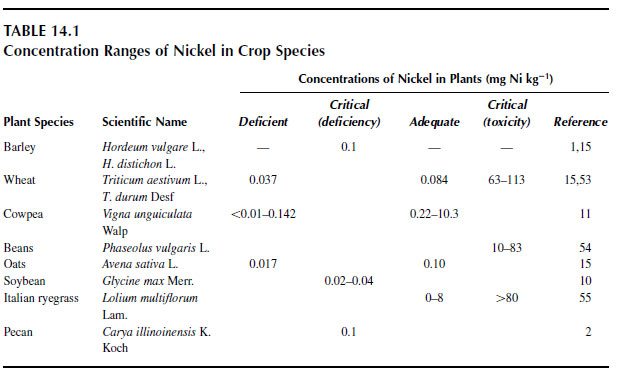Concentration of Nickel in Plants
The nickel concentration (Table 14.1) in leaves of plants grown on uncontaminated soil ranges from 0.05 to 5.0 mg Ni kg-1 dry weight (27,44,45). The adequate range for nickel appears to fall between 0.01 and 10 mg Ni kg-1 dry weight, which is an extremely wide range compared to that for the other elements (5). The critical nickel concentration required for seed germination in barley, shoot growth in oat, barley, and wheat, and shoot growth of urea-fed tomato, rice, and zucchini (Cucumus pepo var. melopepo Alef.) has been estimated independently by two groups to be approximately 100mg Ni kg-1 (1,5), which is similar to the recently determined Ni requirement for pecan (2). |
Nickel concentrations above the toxicity levels of >10 mg kg-1 dry weight in sensitive species, and >50 mg kg-1 dry weight in moderately tolerant ones (44,45,46) result in impaired root and shoot growth without any remarkable defining characteristics (47).
The nickel content of a plant is determined by the nickel availability in the soil, plant species, plant part, and season. Plants growing on serpentine soils (derived from ultramific rocks) or contaminated soils can accumulate high levels of nickel and other heavy metals (48,49). In naturally occurring high-nickel soils (serpentine soils) highly specialized plant species have evolved including several species that hyperaccumulate nickel, sometimes up to 1 to 5% of tissue dry weight (50,51). Species growing on the same soil can also vary dramatically in nickel content and within plant distribution. In general, nickel is transported preferentially to the grain, particularly under conditions of marginal nickel supply (52).




